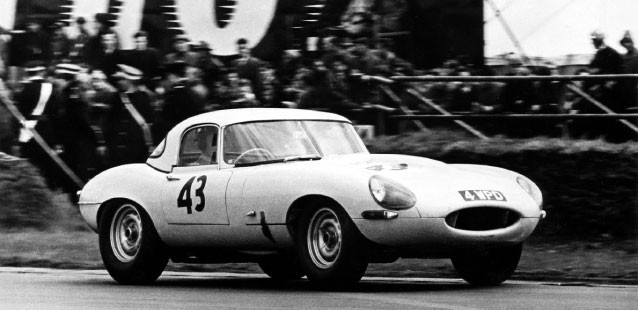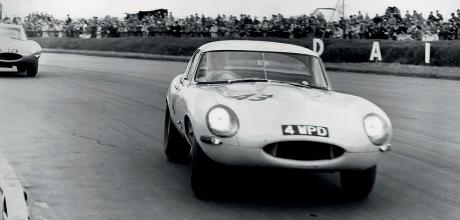Graham Hill wins Silverstone in the lightweight Jaguar E-Type Prototype, May 1963
Jaguar might have pulled out of international motorsport in the mid ’50s, but with privateer teams competing with the E-Type soon after its debut in early 1961, the company continued to have a strong presence on the track well into the 1960s. One of the most famous and successful of these teams was John Coombs, the Guildford-based Jaguar dealer whose team had enjoyed previous success with a 3.4 saloon. In April 1961 he took delivery of the sixth production E-Type open-two seater produced (chassis 885006) and had it registered BUY1.
FINISHING LINES
The car was quick from the outset and in the hands of Coombs regular Roy Salvadori, finished well throughout the season, winning Crystal Palace’s Norbury Trophy in May. To keep the car competitive, 885006 was rebuilt over the winter using aluminium panels and later fitted with improved braking and stiffer suspension. It was also re-registered 4WPD. Yet even with that year’s Formula 1 champion, Graham Hill, behind the wheel, it was still no match for the new Ferrari 250 GTO and so once the 1962 season was over, the car was transformed into a pure racing car.

With Coombs working with Jaguar’s competitions department, even sending his own Ferrari 250 GTO to Browns Lane to be evaluated by both the engineers and aerodynamicist Malcolm Sayer, his E-Type became the prototype for the official lightweight model. The aluminium panels were made even lighter and the boot lid now featured a row of small vents for cooling the rear disc brakes. The XK engine had a new aluminium block, a dry sump and fuel injection while the original close-ratio gearbox was replaced with a five-speed ZF unit. The E-Type’s first race in this new lightweight, higher-performance form was at the Snetterton circuit in Norfolk on 30 March, 1963. Again driven by Hill, the car was immediately quick and he won with ease as he did at Goodwood two weeks later.
Yet these were very much provincial events; due to its larger, more competitive grid, a tougher test came on 11 May at Silverstone’s prestigious International Trophy meeting. After taking the lead, Hill was soon overtaken by Mike Parkes in Coombs’ own GTO at Woodcote Corner with Roy Salvadori in the lightweight E-Type of Tommy Atkins (89PJ) a close third.
“Try as they might, neither Hill nor Salvadori could get ahead of the Ferrari,” said Autosport’s later race report. “Parkes, Hill and Salvadori were certainly giving the crowd their money’s worth – their progress through Woodcote being somewhat frightening.” With four laps to go, this constant pressure from the two Jaguar drivers eventually caused Parkes to lose control at Becketts, giving Hill the lead. Yet victory still wasn’t assured.
“Salvadori thereupon decided to change the picture,” continued Autosport. “On the last lap but one, Graham conceded Club Corner and they tore up Abbey Curve and through Woodcote literally nose-to-tail.” After easing ahead, Salvadori spun at the same place as Parkes a few minutes earlier. “Going into Becketts,” said the British driver in an interview years later, “I did exactly the same thing as Parkes. I don’t know what was wrong.
I never ever thought you’d get into trouble there, and the car just turned back to front and went off the road. But fortunately I didn’t bend the car and got back on the road. And that was that.” His mistake allowed Hill to take 4WPD’s biggest victory to date, securing its place in the long and distinguished line of historically important racing Jaguars.
The E-Type spent one more year with Coombes when it was driven by future F1 champion, Jackie Stewart. But after winning only once at Crystal Palace, it was soon clear 4WPD was outclassed and was sold during 1964. The car was continued to be raced at a reasonably high level for the next few years including by a young Brian Redmond who would later win the Le Mans 24 Hours in 1978 and 1980. After being crashed in 1995 and again 2006, 4WPD was meticulously restored two years later to its 1963 specification.
This significant E-Type continues to be raced successfully at historic motorsport events across the globe.


